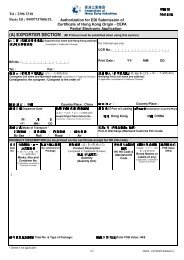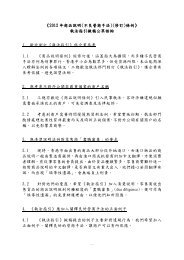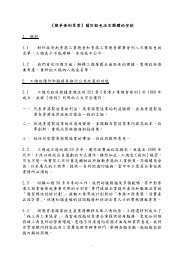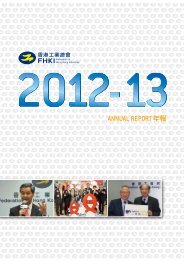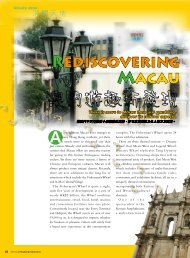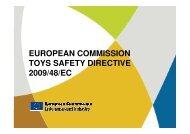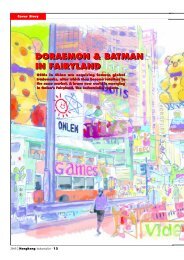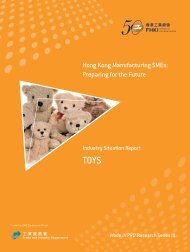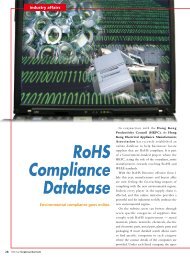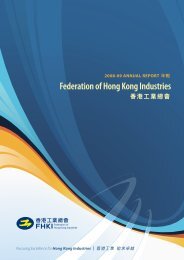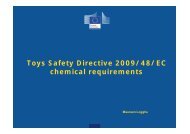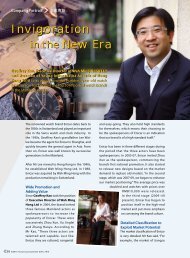Hong Kong Manufacturing SMEs: Preparing for the Future
Hong Kong Manufacturing SMEs: Preparing for the Future
Hong Kong Manufacturing SMEs: Preparing for the Future
- No tags were found...
You also want an ePaper? Increase the reach of your titles
YUMPU automatically turns print PDFs into web optimized ePapers that Google loves.
62What really differentiates Suga is its focus onspecialised products. These products are notas vulnerable to market fluctuation as generalproducts, and <strong>the</strong>y tend to have a higher profitmargin than general products. By being <strong>the</strong> leadingmanufacturer of a niche product, Suga becomesmore important to <strong>the</strong> customers that havedeveloped <strong>the</strong> markets <strong>for</strong> those products. This fact,and <strong>the</strong> investment that is made in developing <strong>the</strong>specialised technology, creates barriers to entry inSuga’s markets which means that o<strong>the</strong>r companieswould find it harder to compete with Suga. It alsomeans that Suga grows alongside its customers,scaling up in a way that is more measured andlower in risk than if Suga had to add capacity andpunt on where demand might come from. In 2009,specialised products represented 60 per cent ofSuga’s output.Suga’s success is reflected in its Chinese companyname which means <strong>the</strong> “best integrity.”Adherence to this characteristic played a pivotalrole in Suga’s early success. In 1992, Mr Ng made abusiness pitch to a large Japanese customer whenSuga was small. At that time, <strong>the</strong> large Japanesecustomer had a new product, <strong>the</strong> LCD TV, and<strong>the</strong>y were looking <strong>for</strong> manufacturers. When Mr Ngmet with <strong>the</strong> large Japanese customer, <strong>the</strong> seniorexecutives asked him about his relevant experienceand he commented that he had none in makingLCD televisions, but that <strong>the</strong> company had o<strong>the</strong>rrelevant experience, was willing to learn, andwould welcome <strong>the</strong> opportunity to work with<strong>the</strong> large Japanese customer and to receive earlysupport from <strong>the</strong>m including instruction as tohow <strong>the</strong>y would like <strong>the</strong> product to be assembled.Somewhat unexpectedly, <strong>the</strong> large Japanesecustomer gave Suga <strong>the</strong> contract even thoughSuga was <strong>the</strong> smallest bidder. The large Japanesecustomer executives in<strong>for</strong>med Mr Ng that <strong>the</strong>approach taken by all <strong>the</strong> o<strong>the</strong>r companies that<strong>the</strong>y met with was to say “oh we can do it, noproblem, it’s easy” and <strong>the</strong> decision was taken togive <strong>the</strong> work to Suga because Suga was honestand upfront when o<strong>the</strong>rs were not. Today <strong>the</strong>large Japanese customer is still Suga’s customerand on <strong>the</strong> back of <strong>the</strong> commitment made to Sugaby <strong>the</strong> large Japanese customer, as well as Suga’sper<strong>for</strong>mance <strong>for</strong> <strong>the</strong> large Japanese customer,<strong>the</strong> firm managed to take on a total of three bigJapanese customers in a relatively short periodof time. This spearheaded Suga’s fast growth inbusiness.An unintended positive consequence of managingto secure a few large Japanese companies ascustomers is that <strong>the</strong>y have loyally supported Sugaduring a couple of tough periods by doing thingslike arranging letters of credit <strong>for</strong> <strong>the</strong> companyto use to finance its operation during <strong>the</strong> shortterm.With a letter of credit from a major Japanesecompany, Suga is able to continue to get bankfinancing so that materials could be purchasedwhen needed, <strong>for</strong> instance.Mr Ng also attributes Suga’s success to <strong>the</strong>investments it has made in developing a world-classERP system and in automating whenever possible.These moves have improved Suga’s manufacturingand operating efficiency, as well as <strong>the</strong> quality andtimeliness of its management decision-making.To exploit <strong>the</strong> competitive advantage that comesfrom technological superiority, and to put Suga in aposition of being able to innovate, Suga maintains aleading-edge capability in specialised technology byensuring that its research and development team iswell-trained and that its skills are regularly updated.This includes having <strong>the</strong> research and developmentteam participate in product developmentcompetitions.Planning is important to Suga, as is <strong>the</strong> setting of3-to-5-year strategies which are reviewed annually.Monthly planning and review meetings are heldwith <strong>the</strong> senior management team and during thosemeetings <strong>the</strong>re is an opportunity <strong>for</strong> cross-functionalcollaboration between business units that o<strong>the</strong>rwisemight not have a structured environment in whichto share ideas. The important discussions that takeplace between <strong>the</strong> marketing and engineeringteams, <strong>for</strong> example, sometimes improve newtechnology to make it more attractive to <strong>the</strong> market.



